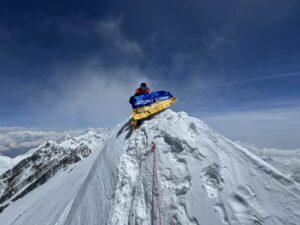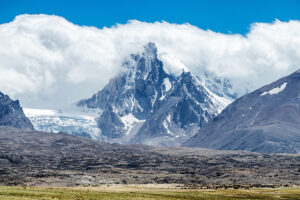Except during short sprints, the fundamental driver of exercise performance in humans is the delivery of oxygen to our muscles. Without it, we can’t turn stored food energy into movement. How much oxygen our muscles receive depends on our heart, lungs and the efficiency of our vascular system — what we often call cardiorespiratory fitness.
On Mount Everest, it’s not just fitness that limits a climbers progress, but the altitude. It’s harder to deliver enough oxygen to the body in thin air. This not only slows climbers down, but can lead to hypoxia (low oxygen in bodily tissues), and acute mountain sickness. That’s why about 97% of climbers use bottled oxygen on Everest.

A modern supplementary oxygen system. Photo: Summit Oxygen
Availability of oxygen on Everest depends on the number of bottles provided by the guiding company, which in turn depends on how much the client is paying. Budget operators typically provide three to five bottles, most Western companies six bottles, some up to 8, and a very few clients have an unlimited supply.
On the Tibetan side, for example, many clients start “sucking O’s” both day and night at the the north col (7,020m). With input from their guide, they must roughly calculate their oxygen flow rate. They of course hit the boost button on the harder, higher sections. On summit day, these calculations aren’t easy to do at 8,500m, after 30 sleepless hours and 20 hours of climbing.
This season, Furtenbach Adventures is testing wearable devices that can measure both vital signs and the location of climbers on Everest, then relay this information back to Base Camp. The information sent includes heart rate, blood oxygen saturation, skin temperature, geo-location, altitude, speed and bearing.

Alan Hinkes pauses on the roof of the world and for a brief moment removes his oxygen mask. Climbers have to be disciplined with their flow rate to ensure they have enough “O’s” to descend safely to lower camps. Photo: Alan Hinkes
Lukas Furtenbach is wearing a heart rate monitor and pulse oximeter (which measures blood oxygen saturation) as he climbs Everest from the north side. Collected data will be transmitted in real-time via satellite, then analyzed by the team doctor at Base Camp, Advanced Base Camp and the North Col.
If this trial run proves successful, climbers and guides will be able to access expert interpretation of real-time blood oxygen saturation (SpO2) in future, in order to make more informed decisions on the flow rate of their supplementary oxygen. This will spare waste and reduce the likelihood of hypoxia.

The sensor for blood oxygen saturation and skin temperature is built into the glove, with data displayed on a wrist-worn unit. Photo: Lukas Furtenbach
It could also detect abnormal heart rate changes, which could indicate if a climber is about to suffer cardiac arrest; or changes in body temperature, which could alert to hypothermia.
Furtenbach told ExWeb: “With the continuous SpO2 measurement, we aim to make [oxygen use] objective. Today we know very accurately, what critical SpO2 can trigger HAPE or HACE. So setting the flow rate according to the SpO2 of the climber is a logical step …that would make expeditions safer and take out much of the risk of HAPE and HACE.”
Monitoring vital signs on Everest isn’t entirely new. Twenty years ago, a Yale University team monitored an array of vital signs at Base Camp and up to Camp 1. And last year, British guide Kenton Cool chose to immediately descend former Olympian Victoria Pendleton from Camp 2 after a pulse oximeter put her Sp02 levels at a death-defying 28%. At sea level, most of us would record 99-100%.
But what is new is the ability to relay this information from extreme altitude in real-time. If the pilot test is successful, eventually all climbers may sport wearable devices on their high-altitude ventures.
Relevant Links
Telemedicine: To Mount Everest and Beyond
Former Olympic Cyclist Forced to Abandon on Everest






